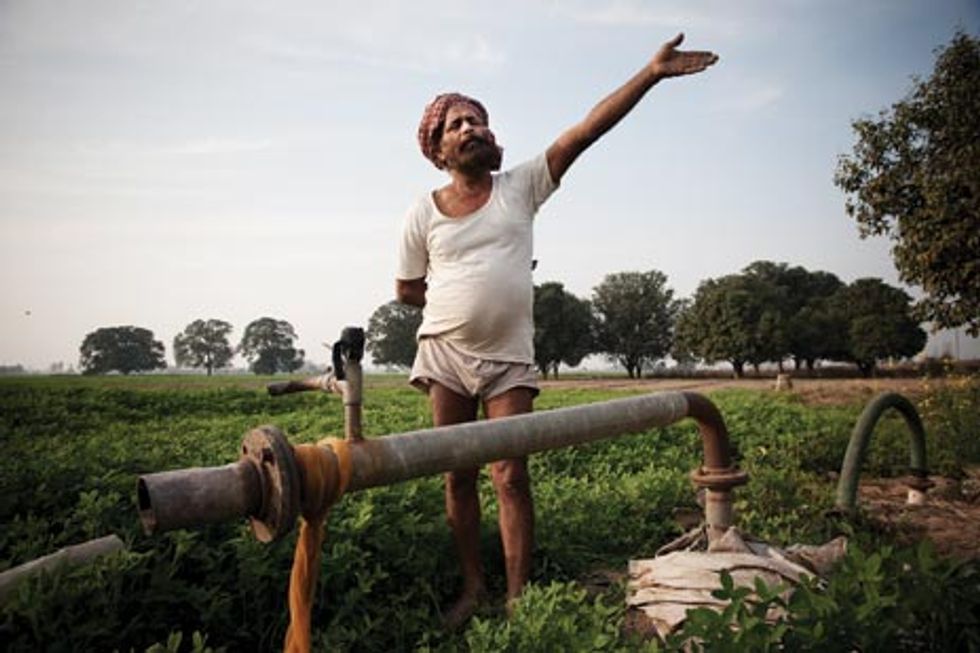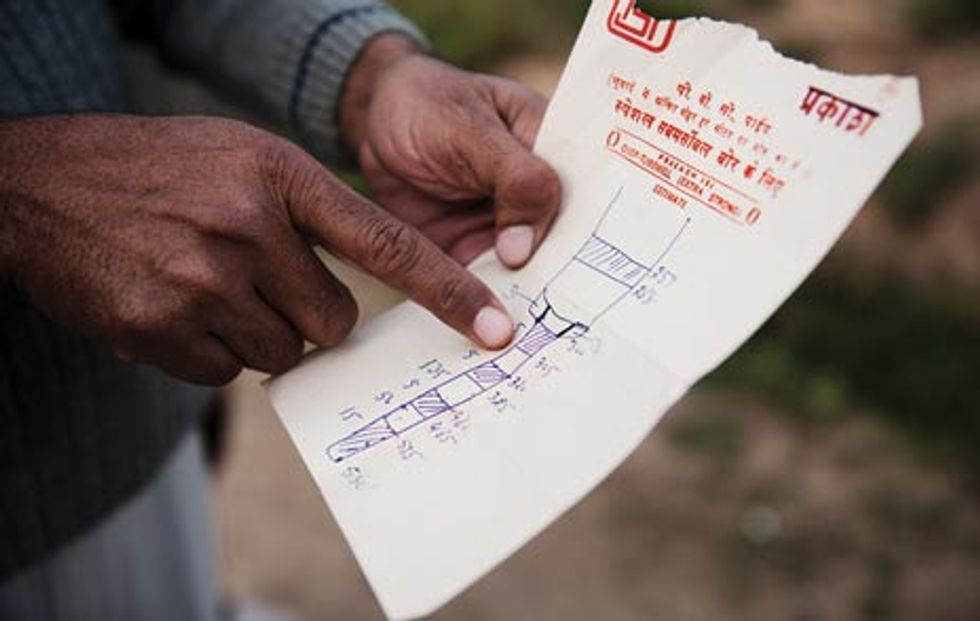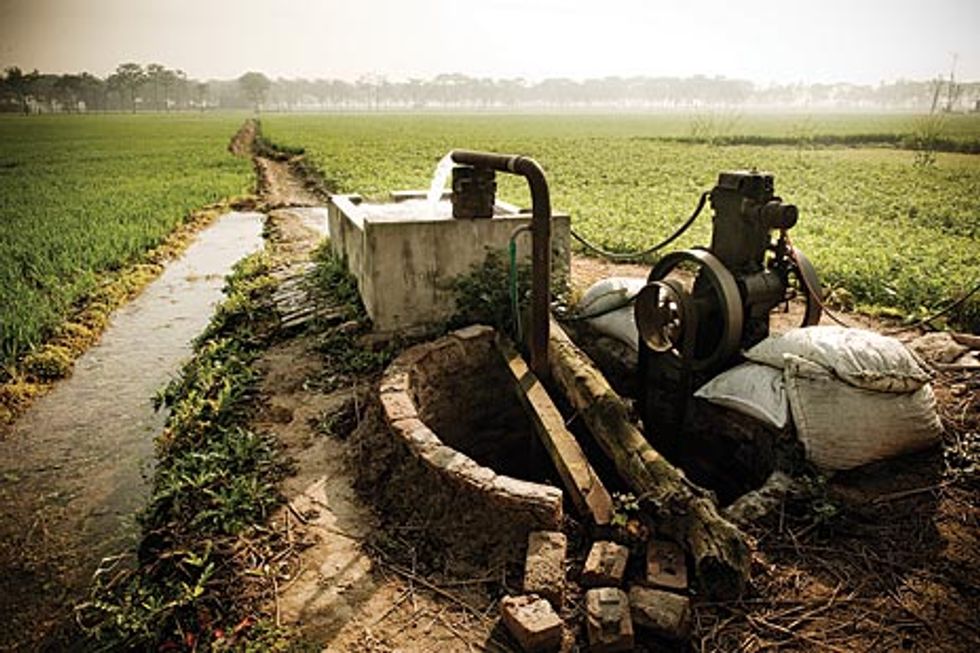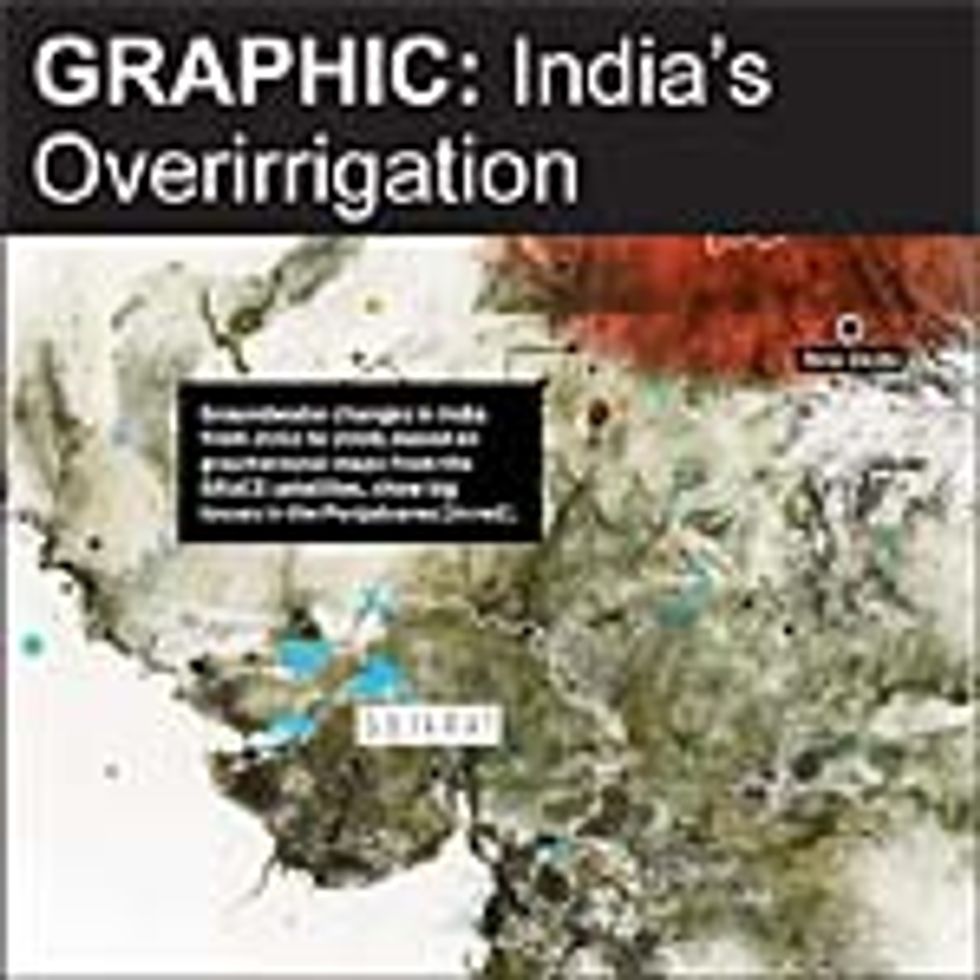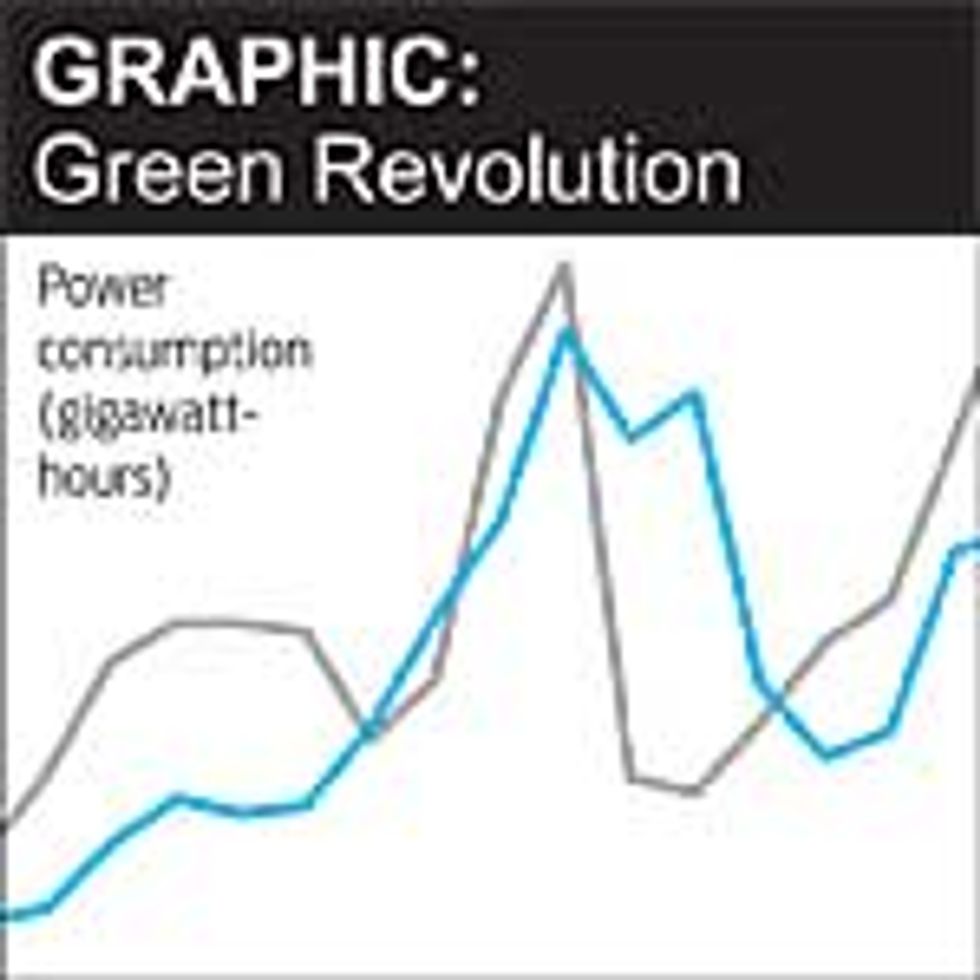Pumping Punjab Dry
Cheap energy endangers India’s ability to feed itself
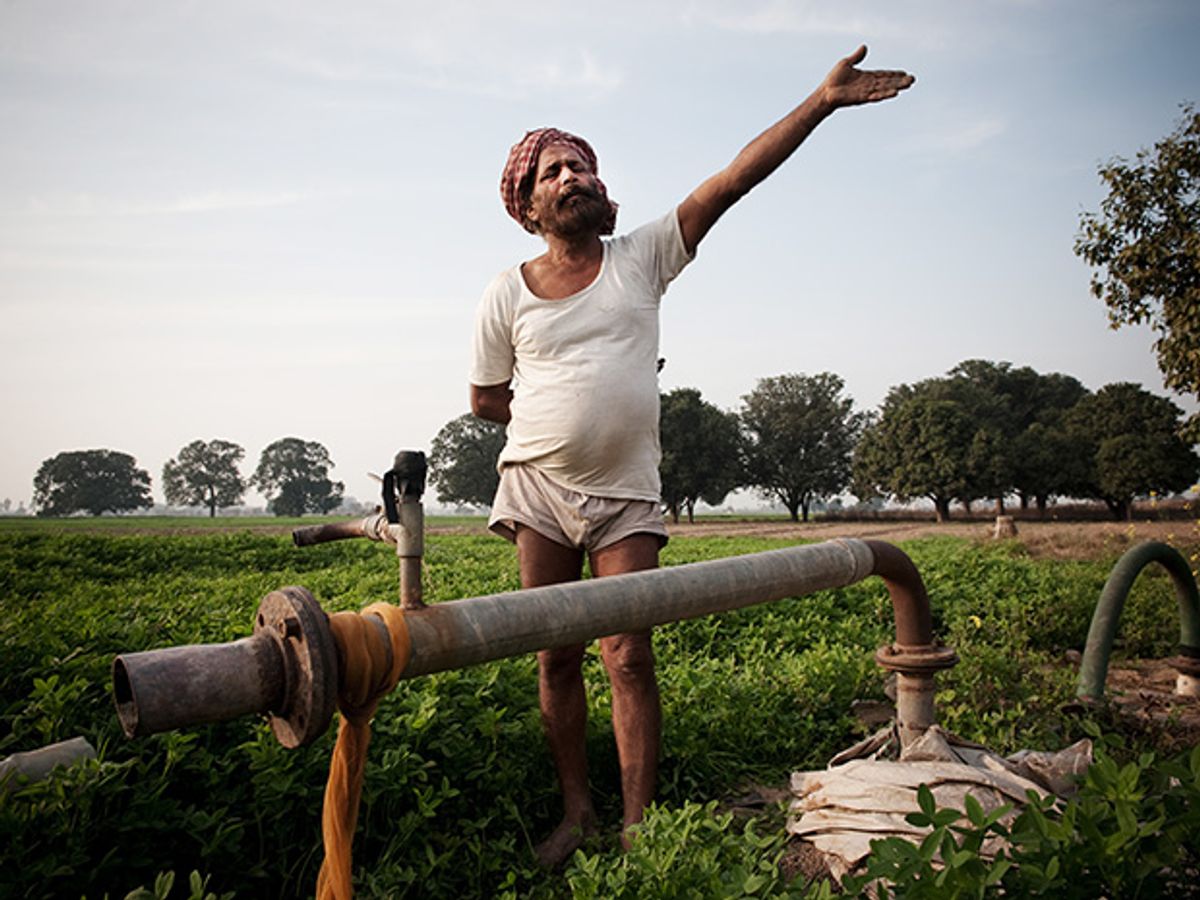
The northern Indian state of Punjab is the country’s historic breadbasket, and 60-year-old Harnek Singh is one of the million farmers who work its soil. On a sunny February afternoon in Khunimajra, about 275 kilometers from New Delhi, he is busy repairing his tube well. The tube well is simple: a steel pipe bored into the ground and attached to a cheap electric pump. This rudimentary tool is the engine of Singh’s success as a farmer. But it and millions of others like it are quickly draining away India’s agricultural riches.
In dirt-covered shorts and an undershirt, Singh squats amid the thick foliage that feeds his 50-odd cattle, preparing his pump for the day’s most critical event. He’s about to get the 4 hours of free electricity that lets him extract water from a natural reservoir 82 meters underground. These days, that hardly suffices. He needs another 8 to 9 hours of power to finish watering his wheat and rice. So he’ll continue to run the pump with diesel generators, which cost him US $4.50 an hour in fuel—a crushing price, considering that his farm’s annual revenue is just $20 000. “Sometimes the [grid] electricity goes off after 2 or 3 hours, and I want to commit suicide,” says Singh.
Even so, farmers are emptying Punjab’s aquifers at an alarming rate. Each year, as the groundwater table steadily retreats, they are forced to go half a meter deeper to pump water. Two abandoned wells on Singh’s farm offer proof of the changing conditions. If cultivation continues here as it has, the groundwater—the source of most of Punjab’s irrigation—could be exhausted in 20 years, say researchers at Punjab Agricultural University, in Ludhiana.
The situation is not unique to Punjab. Collectively, India’s farmers extract about 212 million megaliters of water each year to irrigate some 35 million hectares. That amount of water—enough to submerge London by more than 100 meters—is considerably more than what flows into the aquifers through rainfall and runoff, and plummeting water tables now plague other areas as well. Based on its aquifers’ natural rate of recharge, Punjab can sustainably support at most 1.8 million hectares of rice, according to the state’s director of agriculture, Balwinder Singh Sidhu. At present, it has 2.8 million hectares of rice. If the situation doesn’t change, a food crisis in India seems imminent.
A main culprit is grossly underpriced electricity. For decades, it’s allowed farmers to pump groundwater at very low cost. Now, not only is the water running out, but India’s electricity utilities lack the revenue to maintain their infrastructure and provide rural communities with adequate power.
It’s odd to even be talking about India’s faltering agricultural sector, because in so many ways the Green Revolution that began in the mid-1960s has been a magnificent success. As the country’s farmland grew tenfold, India went from frequent famines to food self-sufficiency, even as its population more than doubled.
Punjab is important to India’s ability to feed itself. Despite its small size, it accounts for about a fifth of the country’s wheat and more than a tenth of its rice. What’s more, its productivity has grown by an order of magnitude, to 11.5 metric tons of rice and wheat per hectare, the highest output in the world, says G.S. Kalkat, the chairman of the Punjab State Farmers’ Commission. But because nearly all the state’s farmland is irrigated, this agricultural bonanza has come at the expense of the state’s groundwater.
How did unrealistic electricity pricing make that happen? India’s electricity grid is largely controlled by about 20 state boards. The first of these was created in 1948, to move the control of power generation away from private operators. But the boards never managed to operate in good financial health, and grid infrastructure began to deteriorate. Soon enough, power shortages became routine.
In the mid-1970s, state governments began to shift to a system of low, flat electricity tariffs for farmers, on the premise that the utilities’ profits from the agricultural sector were too small to justify the cost of installing electricity meters. But as the agricultural revolution gained momentum, groundwater use shot up, while electricity rates remained flat. Several states, including Andhra Pradesh, Madhya Pradesh, and Maharashtra, as well as Punjab, went even further and made power free for farmers. The politicians in these states viewed the move as an easy way to bolster their populist credentials and gain rural votes.
Only recently did that arrangement begin to change. Under pressure from the World Bank and the Asian Development Bank, a few states scrapped free power in 2005 and reverted to a system of subsidized pricing. But not Punjab, which continues to dole out free electricity.
As farmers’ electricity use grew in Punjab, the quality, reliability, and supply of that electricity all declined. Back in the 1980s, farmers could expect 18 hours of electricity a day; now it’s at most 6 hours. And because the groundwater table has been falling at about half a meter each year, farmers actually need more energy every year to irrigate the same field. Though Punjab authorities aren’t doing the math themselves, a back-of-the-envelope calculation shows that raising the 8 ML needed to irrigate one hectare of rice by an extra half meter requires at least an additional 11 kilowatt-hours each year. (That’s the energy needed to lift nearly 30 empty Airbus A-380s.) India’s Central Electricity Authority has estimated that electricity demand will outstrip supply in Punjab by as much as 28 percent this year.
India’s electrical failings aren’t really the farmers’ fault, of course. A third of the nation’s installed capacity of 157 gigawatts gets lost in the system, either from technical problems in the transmission and distribution systems or from theft. Even in the states with relatively well-run grids, less than 65 percent of electricity use is metered. Many Punjab farmers are now clamoring for metered electricity, which would be cheaper than running a diesel generator. “No farmer has demanded free power,” says Singh, the farmer in Khunimajra. “Please charge [for it] and give us an assured supply.”
Though some farmers agree with Singh, clearly others do not. Traditionally, electricity has been viewed as a social benefit rather than a service to be paid for. Those politicians who’ve tried to change the system haven’t fared well. When he was chief minister of the southern state of Andhra Pradesh, N. Chandrababu Naidu introduced metering; he was ousted in the next election. Cases like Naidu’s cause Tushaar Shah, a researcher at the International Water Management Institute, based in Colombo, Sri Lanka, to wonder whether the Punjab farmers are in earnest. “Many people have told me that Punjab farmers want metered power supply,” he says. “But I am not sure they will be willing to pay 4 to 5 rupees [$0.09 to $0.11] per kilowatt-hour for a 24-7 metered power supply.”
Though Punjab falters, the coastal state of Gujarat has managed to overcome similar circumstances. As in Punjab, flat electricity tariffs in Gujarat led to mounting financial losses for the state electricity board and the rapid depletion of aquifers. It also spawned an informal water market in which tube-well owners sold surplus water to poorer farmers who couldn’t afford tube wells or couldn’t get permission to install them.
In 2003, Gujarat’s state officials came up with a plan to improve the power supply in rural areas and curb groundwater consumption. A $254 million parallel rural transmission network was laid across the state, with feeders for supplying agricultural users separated from those going to commercial and residential users. Tube-well owners now pay the market rate for full-voltage power for 8 hours a day—just long enough to irrigate an average-size field, the state’s regulators figured. Experts say the scheme has cut groundwater pumping on medium and large farms. The farmers have benefited, too: Continuous and full-voltage power means less wear and tear on the tube wells’ electric motors.
What’s more, villages in Gujarat now have electricity around the clock, of a quality seldom seen in rural India. Access to reliable electricity has in turn led to a better drinking water supply and improved street lighting; rice and flour mills, telephone exchanges and kiosks, and computer-training centers are thriving. A study of 55 villages by the International Water Management Institute in 2008 concluded that the scheme had managed to cap groundwater withdrawal in a fair manner.
But not everyone has prospered. The state’s small tenant farmers, who relied on the informal water market to irrigate their crops, have largely been cut out of the new system, according to a survey by the Columbia Water Center India (part of the Earth Institute of Columbia University, in New York City). To assist those poorer farmers, the state government is subsidizing new tube-well connections, which previously it had banned, says Shah, who headed the International Water Management Institute’s study. In the last three years, the state has issued 200 000 new connections, he says, mostly to small farmers.
“Gujarat has more or less resolved the energy-water nexus to the extent it is resolvable,” Shah says.
Gujarat’s example proves that reform can work. But Gujarat may not hold all the answers for Punjab, says Kalkat, the chairman of Punjab’s farmers’ commission. He worries about the effect of metering on Punjab’s small farms—how will they pay for their electricity? Kalkat favors alternatives that avoid the thorny politics of electricity pricing.
Some of these alternatives are already reducing water use. Two years ago, Punjab passed a law that sets a date close to the monsoon season when farmers can start sowing their fields; previously they would sow much earlier and thus pump more water. Groundwater data shows that the law has had some benefit, says Sidhu, the state’s director of agriculture. Punjab is also introducing new varieties of rice that grow faster and use less water.
To trim water use further, the state agriculture department is now helping farmers laser-level their fields. Farmland that isn’t flat requires as much as 25 percent more water. Using lasers attached to high-power tractors, workers can measure the terrain and then scrape away the excess grade. As of last June, Punjab had about 700 laser levelers operating. As a result, some farmers have largely been able to stop using groundwater for irrigation.
Kamal Vatta and Rupinder Singh Sidhu, professors at the Punjab Agricultural University, say that the water savings could go much further if state subsidies were revised to favor less-thirsty crops. At present, they say, incentives for growing rice essentially pay for the entire cost of extracting groundwater, including the diesel generators. As a result, farmers feel no pressure to shift to crops such as corn, which requires a quarter of the water needed for rice but commands a much lower subsidy.
Whether water conservation and agricultural policy will be enough in Punjab or whether, as in Gujarat, a new electricity infrastructure is needed might not be clear for some time. At the rate Punjab’s groundwater is disappearing, time is something India may not have enough of.
To Probe Further
Check out the rest of the special report: Water vs Energy.
